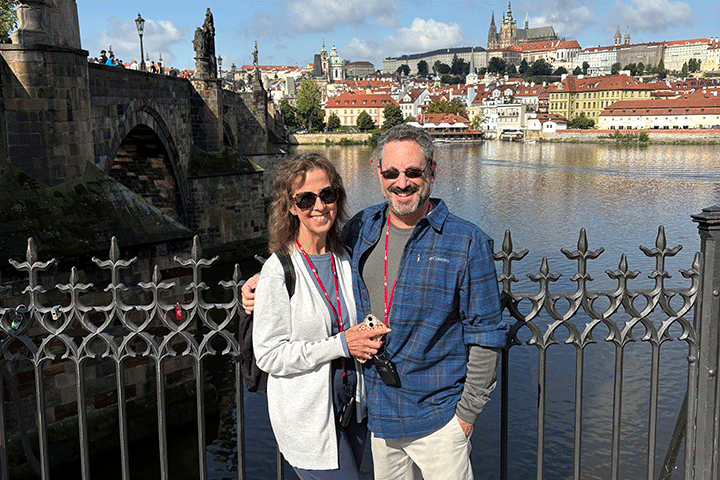Where Sorrow and Joy Meet

- Abdominal bleeding leads to PNET diagnosis
- Surgery to remove the tumor appears successful, but new tumors appear in liver
- Lanreotide injections not effective but specialized radiotherapy helps
- PNETs return, so treatment repeated
I was diagnosed with a pancreatic neuroendocrine tumor (PNET) in early January 2015 when I was suddenly and unexpectedly hospitalized with internal bleeding.
I first noticed some problems a month before that. I’m a casual runner, running a couple of miles about three times a week. But at the start of December 2014, I noticed a sharp decline in my stamina. I was only able to run a mile, and I felt exhausted. I just assumed that I was out of shape (it was not long after Thanksgiving and my birthday, both of which involved eating a lot).
But over the next couple of weeks, the symptoms got worse. I was tired, dizzy, and nauseous. There was a bad flu going around that year, and I knew a lot of people who were sick, so I just assumed I had the flu. But it was odd that I didn’t have a fever, chills, or the achiness of the flu. By the end of December, I was barely able to get out of bed, and on December 31 and January 1 I had two incidents of vomiting blood, which led to hospitalization on January 2.
Upper GI endoscopy revealed a mass on the tail of my pancreas, pressing against the spleen and causing bleeding. CT and MRI scans revealed tumors throughout the liver. A couple of days later, the pathology report confirmed intermediate grade PNET.
A Plan of Attack for PNET
This was a complete shock to everyone, because until a month before I’d been healthy and active. As it turned out, my PNET was non-functional, meaning that it was not secreting hormones, so I did not experience any of the symptoms that many NET patients present with, sometimes for years, before being correctly diagnosed. In my case, I had probably had PNETs for a fairly long time, which grew and spread unnoticed inside of me until its presence caused structural problems.
The first plan of attack was surgery on January 29, 2015, to remove the primary tumor on the tail of my pancreas, as well as my spleen, my gall bladder, and portions of my liver. This was in fact my first surgery of any kind, and so I liked to joke to my friends that I didn’t like to do anything unless I could do it big. And was it ever big. Dr. Ronald Busuttil, my surgeon at UCLA Medical Center in Los Angeles, (now retired) found that my liver was, aside from the cancer, very healthy, so he opted for an aggressive approach. At the conclusion of my surgery he told my wife, “I got it all.”
In March 2015 I had a follow-up MRI to look at my liver. Unfortunately, even though it was just two months since my surgery, there were already new tumors in my liver. Working with oncologist Dr. Joel Hecht at UCLA, I started receiving monthly injections of the somatostatin analog lanreotide. In my case, since my PNET was non-functional, the lanreotide was for anti-tumor properties rather than hormonal control.
I continued (and continue) to have MRI scans at three-month intervals. Despite the lanreotide injections, the tumors in my liver continued to increase in number and size. In December 2015 and January 2016, I had radiofrequency ablation (RFA) to destroy the liver tumors, but a subsequent MRI showed that there were now more than 20 small tumors throughout the liver.
Trying Experimental Treatments
I was able to have a Gallium-68 dotatate scan (not yet FDA-approved at that time) as part of a clinical trial at UCLA. The Ga-68 scan is highly sensitive and specific to NET by detecting the presence of somatostatin receptors on the tumors. The results of the scan were positive. My tumors expressed a large number of receptors, which made me a good candidate for peptide receptor radionuclide therapy (PRRT). The Ga-68 scan also detected bone lesions.
In 2017 PRRT was not yet FDA-approved in the United States, but it had been widely used for 20 years in Europe for treatment of PNET. I was accepted to receive four rounds of PRRT at Excel Diagnostics in Houston under the Texas Right to Try law.
I tolerated the PRRT extremely well. Aside from a week or two of mild flu-like symptoms after each round, my bone marrow and kidneys were not affected. In January 2017, six months after the first round of PRRT (and almost exactly two years after my diagnosis), my MRI and Ga-68 scans were unbelievable: They showed no evidence of PNET. The doctor reading the scan had to double-check to make sure that he had the correct patient’s scan! We had been hoping for, at best, “stable disease” (i.e. no progression), but I had had a “complete response” to the PRRT. All the tumors in my liver and the lesions in my bones had vanished.
Cancer-Free . . . At Least For a Time
Obviously, my wife and I, my family, and my friends were all overjoyed by this news. For me, it was hard. Of course, I was happy to be “cancer-free,” but I knew that it was likely only going to be a temporary break from PNET. PNET is like the bad comic book character who you think has been destroyed, but they suddenly reappear in the sequel.
Also, I was still having debilitating abdominal pain, a lingering side effect of the surgery I’d had two years before.
Managing this pain became a project just as large as managing the cancer. I was very fortunate to find a pain management specialist at UCLA, Dr. Najmeh Sadoughi, who prescribed a strategy where instead of just hitting the pain with a single giant hammer (narcotics), we would use a number of drugs, each one at a small dose, and then wean me from those drugs one at a time. This approach, combined with physical therapy, got me back to “almost normal” by 2018. In July 2018, my wife and I celebrated with a trip to Iceland, where I was able to do strenuous hiking with very little pain.
In 2019, my comic book nemesis, PNET, reappeared. My Ga-68 scan showed small bone lesions. A follow-up scan three months later showed an increase in the number of lesions as well as some small tumors in my liver. The “good news” was that the Ga-68 scan showed that the tumors continued to have somatostatin receptors, so I was a candidate for retreatment with PRRT. By this time, PRRT had been FDA-approved in the U.S., so I was able to have two rounds of PRRT at UCLA. It was a blessing to be able to drive less than two miles to get PRRT instead of flying two hours to Houston!
I had an MRI on October 9 which showed NO EVIDENCE OF DISEASE! Hooray! I’m scheduled to have a Ga-68 scan December 4. The Ga-68 scan is better at detecting PNET metastases in the bones, so there’s always the possibility that the scan will show small areas of activity in the liver or pancreas that the MRI can’t detect. But the good news is that comparison of previous and current MRI scans shows that I had an excellent response to the PRRT. Hopefully this means I can go for another year or two without needing any additional treatment. There are new and better kinds of PRRT currently in clinical trials, so maybe by the time I need it again, I’ll be able to get into one of those trials.
Fighting cancer feels like a game of chess. You make a move and you need to start planning your next move based on your opponent’s possible next moves!
My Musical Talent Expresses my Uncertainty
At this point I’m living in a state of uncertainty. The interesting thing though is that I’m okay with that. I’ve learned that all of life is uncertain, not just when you have cancer. In fact, if I ever thought I had everything under control, that was an illusion; this new state of being, accepting that I’m not in control, is what’s real.
Over the last four (almost five now) years, my faith has been challenged and made stronger, and my relationships with my wife and my friends have deepened. As an artist, I’ve found tremendous inspiration. I even recorded a CD of music that I wrote during this journey. It’s called Surprised By Beauty, because I really have been surprised by beauty. There’s been a lot of suffering, but there also have been many unexpected beautiful moments. There are two pieces on the CD that I think summarize my life. They are called “Sorrow” and “Joy,” and they are joined together. “Sorrow” is in a minor key, and “Joy” is in a major key. Where they are joined together, they share a single chord, which is missing its middle note, so it’s ambiguous whether it’s major or minor. So, where Sorrow and Joy meet, there’s a moment where it’s both, and that’s the moment I’ve been learning to live in.
Watch Tom tell his story in “We’re in This Together.”






